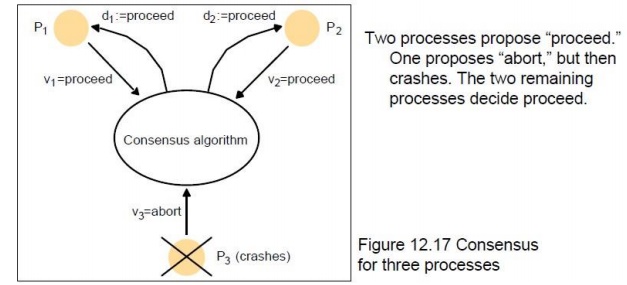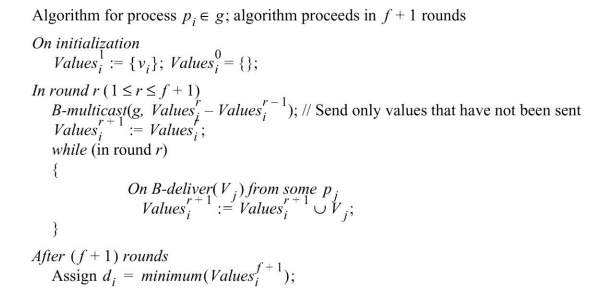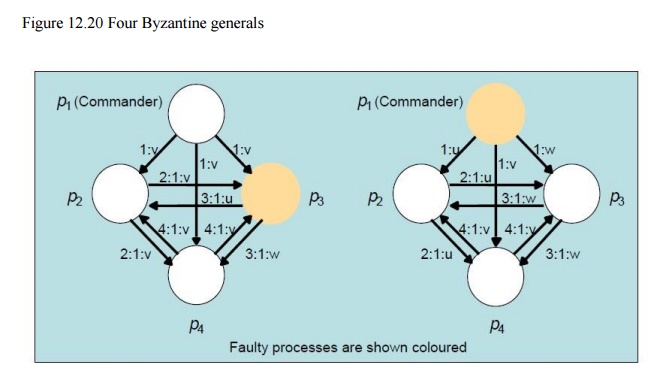Chapter: Distributed Systems : Synchronization and Replication
Consensus and related problems
Consensus and related problems
§ Problems
of agreement
o
For processes to agree on a value (consensus) after
one or more of the processes has proposed what that value should be
o
Covered topics: byzantine generals, interactive
consistency, totally ordered multicast
·
The byzantine generals problem: a decision whether
multiple armies should attack or retreat, assuming that united action will be
more successful than some attacking and some retreating
·
Another example might be space ship controllers
deciding whether to proceed or abort. Failure handling during consensus is a
key concern
§ Assumptions
o
communication (by message passing) is reliable
o
processes may fail
§ Sometimes
up to f of the N processes are faulty
·
Consensus Process
·
Each process pi begins in an undecided state and
proposes a single value vi, drawn from a set D (i=1…N)
·
Processes communicate with each other, exchanging
values
·
Each process then sets the value of a decision
variable di and enters the decided state

·
Requirements for Consensus
§ Three
requirements of a consensus algorithm
o
Termination: Eventually every correct
process sets its decision variable
o
Agreement: The decision value of all
correct processes is the same: if pi and pj are correct and have entered the decided state, then di=dj
·
(i,j=1,2, …, N)
o
Integrity: If the correct processes all
proposed the same value, then any correct process in the decided state has chosen that value
·
The byzantine generals problem
§ Problem
description
o
Three or more generals must agree to attack or to retreat
o
One general, the commander, issues the order
o
Other generals, the lieutenants, must decide to attack or retreat
o
One or more generals may be treacherous
·
A treacherous
general tells one general to attack and another to retreat
·
Difference from consensus is that a single process
supplies the value to agree on
·
Requirements
o
Termination:
eventually each correct process sets its decision variable
o
Agreement: the
decision variable of all correct processes is the same
o
Integrity: if the
commander is correct, then all correct processes agree on the value that the
commander has proposed (but the commander need not be correct)
·
The interactive consistency problem
§ Interactive
consistency: all correct processes agree on a vector of values, one for each
process. This is called the decision vector
o
Another variant of consensus
§ Requirements
o
Termination:
eventually each correct process sets its decision variable
o
Agreement: the
decision vector of all correct processes is the same
o
Integrity: if any
process is correct, then all correct processes decide the correct value for
that process
·
Relating consensus to other problems
§ Consensus
(C), Byzantine Generals (BG), and Interactive Consensus (IC) are all problems
concerned with making decisions in the context of arbitrary or crash failures
§ We can
sometimes generate solutions for one problem in terms of another. For example
o
We can derive IC from BG by running BG N times,
once for each process with that process acting as commander
o
We can derive C from IC by running IC to produce a
vector of values at each process, then applying a function to the vector‘s
values to derive a single value.
o
We can derive BG from C by
§ Commander
sends proposed value to itself and each remaining process
§ All
processes run C with received values
§ They
derive BG from the vector of C values
·
Consensus in a Synchronous System
§ Up to f
processes may have crash failures, all failures occurring during f+1 rounds.
During each round, each of the correct processes multicasts the values among
themselves
·
The algorithm guarantees all surviving correct
processes are in a position to agree
·
Note: any process with f failures will require at
least f+1 rounds to agree

·
Limits for solutions to Byzantine Generals
§ Some cases
of the Byzantine Generals problems have no solutions
o
Lamport et al
found that if there are only 3 processes, there is no solution
o
Pease et al
found that if the total number of processes is less than three times the number
of failures plus one, there is no solution
§ Thus
there is a solution with 4 processes and 1 failure, if there are two rounds
o
In the first, the commander sends the values
o
while in the second, each lieutenant sends the
values it received

·
Asynchronous Systems
·
All solutions to consistency and Byzantine generals
problems are limited to synchronous systems
o
Fischer et al
found that there are no solutions in an asynchronous system with even one
failure
o
This impossibility is circumvented by masking faults or using failure detection
·
There is also a partial solution, assuming an adversary process, based on introducing random values in the process to prevent an effective thwarting strategy.
This does not always reach consensus
Related Topics